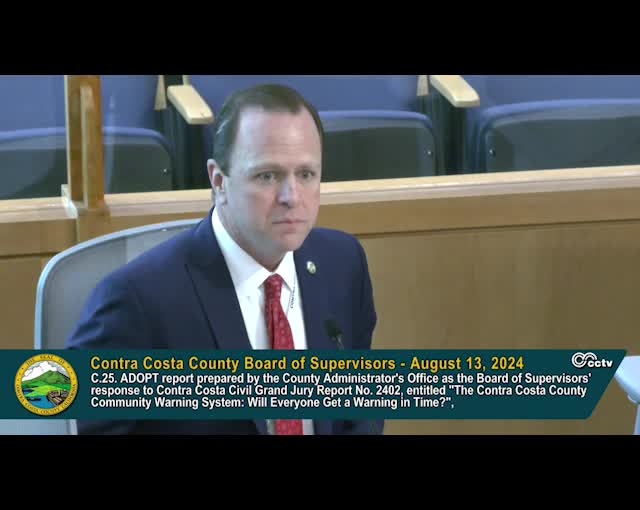Emergency alert system leaves 70% of residents unprotected
August 13, 2024 | Contra Costa County, California
This article was created by AI summarizing key points discussed. AI makes mistakes, so for full details and context, please refer to the video of the full meeting. Please report any errors so we can fix them. Report an error »

In a recent government meeting, officials discussed critical issues surrounding emergency alert systems and the challenges posed by the increasing reliance on mobile phones over traditional landlines. A significant concern raised was that approximately 70% of residents have not registered their cell phone numbers with the Community Warning System (CWS), which could leave them without crucial alerts during emergencies.
The discussion highlighted that while the CWS effectively reaches registered landline users, the voluntary registration rate for cell phones stands at only 30%. This means that a large portion of the population may not receive timely notifications during emergencies, particularly for level two alerts, which advise residents to shelter in place but do not trigger the Wireless Emergency Alert (WEA) system.
Officials noted that the WEA is utilized for life-threatening emergencies, such as level three alerts, but not for level two advisories. This discrepancy raises concerns about public safety, especially in low-income communities where residents may lack registered cell phones. The meeting underscored the need for improved outreach and education to encourage residents to register their contact information.
In response to recommendations from a grand jury report, officials are exploring ways to obtain unregistered cell phone data from service providers to enhance the CWS. They are currently negotiating contracts with utility companies, which could facilitate broader access to contact information for emergency notifications.
Additionally, the meeting touched on the potential implementation of long-range acoustic warning systems, with officials agreeing that further analysis is needed to assess their feasibility. The discussion emphasized the importance of a comprehensive review of the county's emergency management systems, particularly in light of recent challenges posed by wildfires and other disasters.
Overall, the meeting highlighted the urgent need for improved communication strategies and technology integration to ensure that all residents receive critical emergency alerts, regardless of their registration status.
The discussion highlighted that while the CWS effectively reaches registered landline users, the voluntary registration rate for cell phones stands at only 30%. This means that a large portion of the population may not receive timely notifications during emergencies, particularly for level two alerts, which advise residents to shelter in place but do not trigger the Wireless Emergency Alert (WEA) system.
Officials noted that the WEA is utilized for life-threatening emergencies, such as level three alerts, but not for level two advisories. This discrepancy raises concerns about public safety, especially in low-income communities where residents may lack registered cell phones. The meeting underscored the need for improved outreach and education to encourage residents to register their contact information.
In response to recommendations from a grand jury report, officials are exploring ways to obtain unregistered cell phone data from service providers to enhance the CWS. They are currently negotiating contracts with utility companies, which could facilitate broader access to contact information for emergency notifications.
Additionally, the meeting touched on the potential implementation of long-range acoustic warning systems, with officials agreeing that further analysis is needed to assess their feasibility. The discussion emphasized the importance of a comprehensive review of the county's emergency management systems, particularly in light of recent challenges posed by wildfires and other disasters.
Overall, the meeting highlighted the urgent need for improved communication strategies and technology integration to ensure that all residents receive critical emergency alerts, regardless of their registration status.
View full meeting
This article is based on a recent meeting—watch the full video and explore the complete transcript for deeper insights into the discussion.
View full meeting
